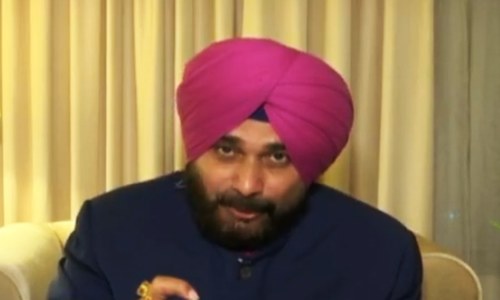
KARTARPUR: A glorious white structure stands tall in the middle of lush green rice fields 2.5 kilometres off Shakargarh Road in Kartarpur. The uneven path leading to it passes through fields on both sides, schoolchildren hopping back home, farmers herding cattle. There are no signs of settlements except those of a few gypsy families.
That magnificent structure is Gurdwara Darbar Sahib in Shakargarh tehsil of Narowal district, around 120km from Lahore. It is just 4km from the Indian border with Dera Baba Nanak on the other side.
The gurdwara recently made headlines following the swearing-in ceremony of Prime Minister Imran Khan where Army Chief Gen Qamar Bajwa assured visiting dignitary cricketer-turned-politician Navjot Singh Sidhu that Pakistan planned to open the Kartarpur corridor for Sikh yatrees on the 550th birth anniversary of Baba Guru Nanak next year. Later, Information Minister Fawad Chaudhry reiterated Pakistan’s desire to do so.
But this isn’t the first time opening the corridor for Sikh pilgrims has been in the news. On the Pakistani side, various proposals have been discussed and announcements made since the Musharraf era, but lack of interest by the Indian side has kept the proposals confined to cold storage.
Several Indian lawmakers have taken up the issue with their governments since the late 1990s. Last year, an Indian parliamentary standing committee, headed by Shashi Tharoor, ruled out the construction of a corridor citing security concerns. Last month, India’s Punjab Assembly adopted a resolution asking the central government to take up with Pakistan the opening of the corridor.
As one enters the gurdwara, on the right side is a small courtyard where lies Guru Nanak’s shrine. On the left side is a courtyard for distributing langar and living quarters. Inside the carpeted hallway is a small samadhi. Upstairs is the main prayer hall where the Guru Granth Sahib is placed, but I was told the hall was ‘closed’ at that time. I was offered the langar that consisted of rice with a channe ki daal.
“Hindus, Sikhs, Muslims, everyone considered Guru Nanak their saint, so when he died on Sept 22, 1539 here, Muslims and Guru Nanak Naam Lewa Sangat got into a feud over who would get his remains. When the sheet covering Guru Nanak’s body was lifted, his body wasn’t there, but only fresh flowers. Both sides divided the sheet and flowers between themselves and Muslims made a shrine for him and Sikhs made a samadhi,” explained Gobind Singh, caretaker of the gurdwara. Gobind has been appointed here by the Evacuee Trust Property Board (ETPB) and belongs to Nankana Sahib.
The gurdwara was reconstructed from 1920 and 1929 by the then maharaja of Patiala, Bhupinder Singh Bahadur, for Rs135,600, and since then has been maintained by the ETPB. During my visit, it was being decorated with artificial flowers for next week’s death anniversary of Guru Nanak. Outside the gurdwara, in a bigger courtyard, is a well that is said to have been used by Guru Nanak to irrigate his fields, and preserved in a glass case is a piece of a bomb; a plaque next to it says was dropped by the Indian Air Force in the 1971 war, but miraculously landed into the well and saved the gurdwara.
Singh says that Sikhs from all over the world visit the gurdwara, though it remained shut from 1947 to 2000. “Pakistan has several times offered to India that it will construct a road to Kartarpur,” says Singh. “The proposals were even approved and during the Musharraf era a tender was floated with 50 per cent of road construction being carried out. But India never responded.”
The caretaker gets slightly emotional when talking about any opening of the corridor. “This has been the biggest demand of the Sikh community,” he muses. Meanwhile, “around 250 Muslims come here daily. Since there aren’t any Hindus or Sikhs living nearby, those from Sindh come every other week. There are no Sikhs, but a lot of Hindus in the district, not anywhere close to the gurdwara though.”
The owners of a couple of makeshift shops selling pakoras and other snacks also see chances of themselves gaining something.
“Sikhs will be able to come here freely and in return the area and its people may also benefit in terms of business,” says Asif. “The price of land here will increase, more shops will open.” Even so, “if the border opens, there will be a lot of strictness as the army will be deployed. Right now, people come from and go to their fields easily.”
Another shopkeeper, Haji Sarwar, says he too has heard about the border opening, and is excited. “It should open. They’ve been saying this for years, but I think it will open this time; it will take time though. Besides Sikhs, local farmers will also benefit. It might eventually be open to other citizens too,” he explains.
But not everyone’s happy with chatter around the corridor opening. A farmer said he stands to lose as any road will be barricaded, cutting access to his fields. “I till 400 acres on both sides of the Ravi. We, the growers, will be at a disadvantage as any road will be lined with barbed wire,” said Amjad, whom I hitchhiked with on his bike to travel the 2km from the gurdwara to the river since the muddy, unpaved track is inaccessible by car.
Published in Dawn, September 18th, 2018












































